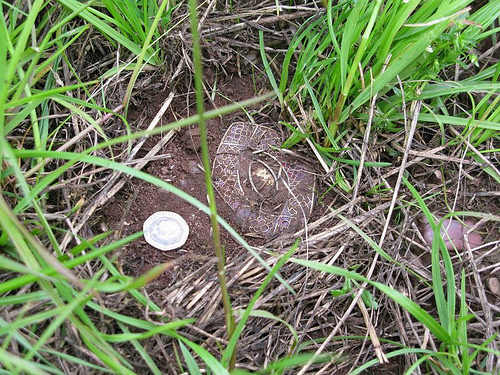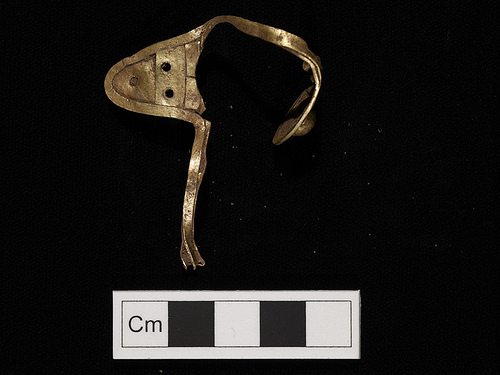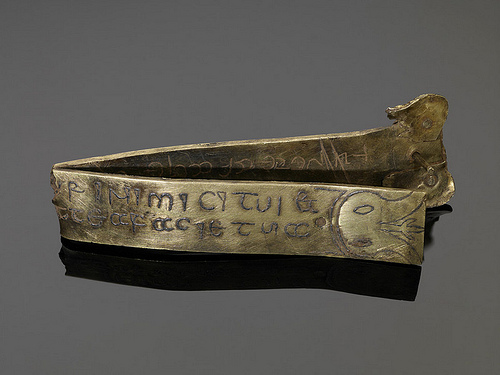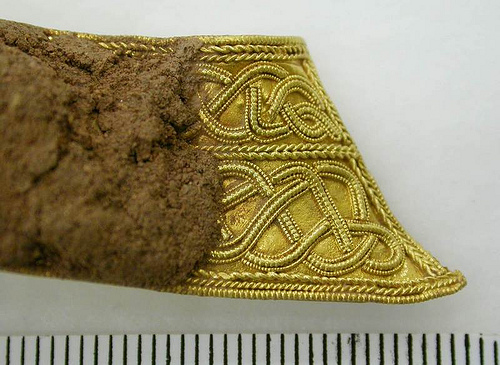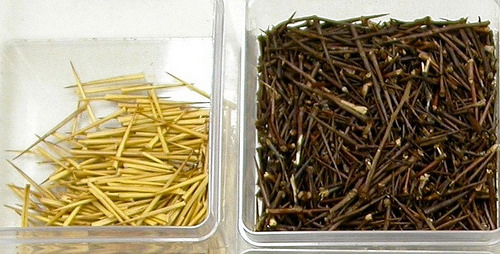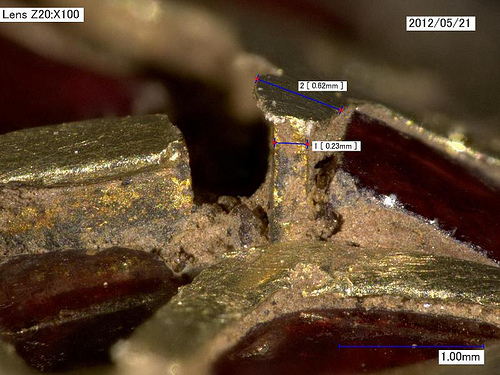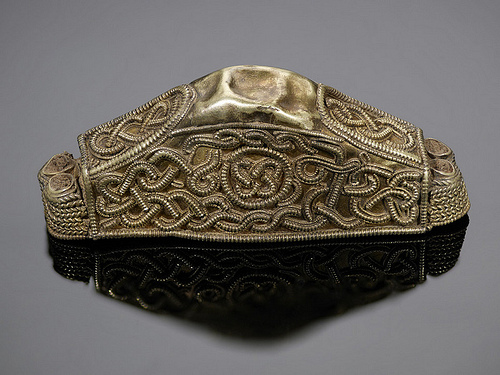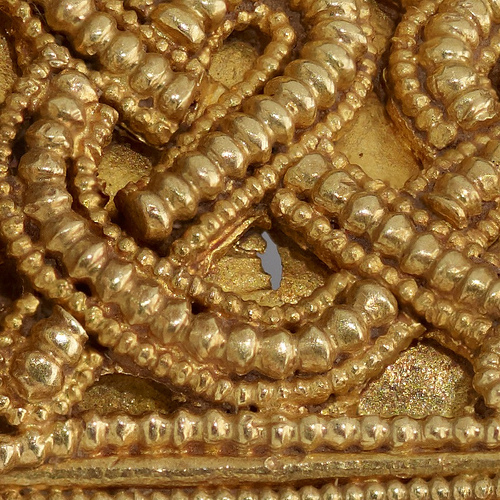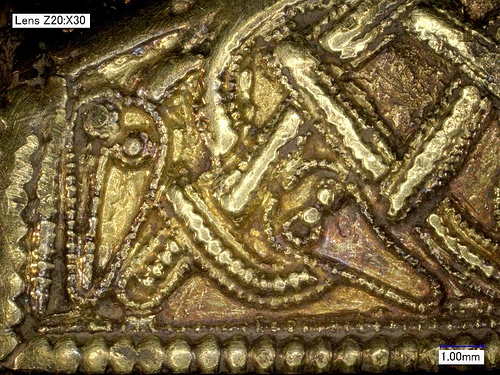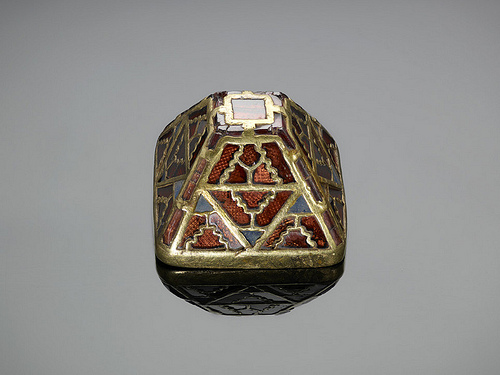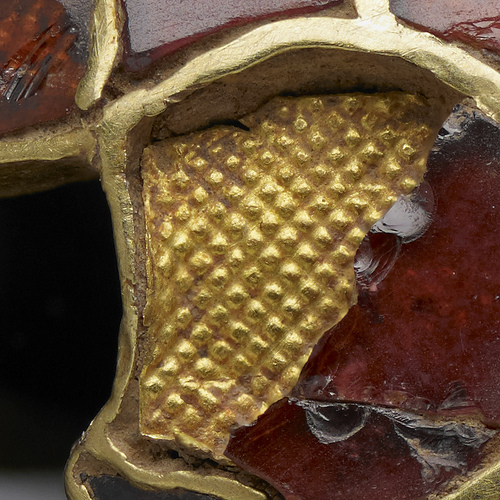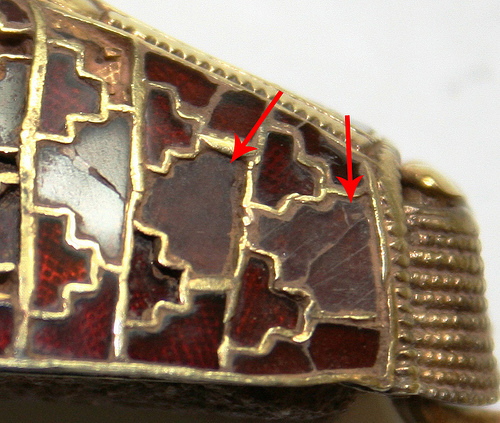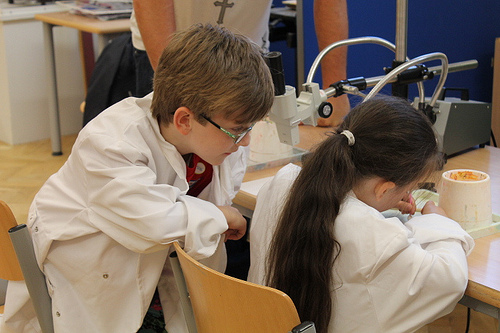The Staffordshire Hoard is the largest collection of Anglo-Saxon gold and silver metalwork ever found, anywhere in the world. Discovered in a field near the village of Hammerwich, near Lichfield, in Staffordshire, England on 5 July 2009, the Hoard totals 5.094 kilos of gold, 1.442 kilos of silver and 3,500 cloisonné garnets. There is nothing comparable in terms of content and quantity in the UK or mainland Europe. It is remarkable for being almost exclusively military in nature, with an extraordinary quantity of pommel caps and hilt plates. Many feature beautiful garnet inlays or animals in elaborate filigree. There are also a small but significant number of Christian objects, including crosses and a biblical inscription.
The finds were jointly acquired by the Birmingham Museum and Art Gallery (BMAG) and the Potteries Museum and Art Gallery, Stoke-on-Trent (PMAG) following one of the most successful public fundraising campaigns in English history, raising the £3.285m (US$5.255m) asking price in less than three months.
______________________________________________
The hoard emerges. Courtesy Birmingham Museum and Art Gallery.
_____________________________________________
The Staffordshire Hoard conservation and research program is a multi-disciplinary collaborative program. The conservation program began in 2010 and has to date conserved over 3500 objects and fragments. It is now beginning to shed light on the technological capabilities and techniques of the Anglo-Saxon craftsmen. The artefacts have tentatively been dated to the late 6th and early 7th centuries, placing the origin of the items in the time of the Kingdom of Mercia.
Since the discovery, experts have theorised about why the hoard was deposited where it was, and whether the treasure was left by Christians or pagans. Every passing day reveals new facts and questions about the Hoard, its history and its heritage, but what we already know is that the average quality of the workmanship is extremely high, comparable to some of the finest known objects in the Anglo-Saxon world. This is especially remarkable in view of the large number of individual objects from which the elements in the hoard came.
The hoard contains mainly fittings from edged weapons, including sword pommel caps. The pommel cap is the tip of the hilt of a sword that anchors the hilt fittings to the sword blade. Single pommel caps from this period are incredibly rare archaeological finds, and to find 93 together is unprecedented.
However, some important elements are missing from the hoard. It does not contain any of the iron sword blades or organic components, such as horn or wooden grips, which would have been part of the original object. All of the objects have historical damage due to their harsh dismantling at some point prior to deposition. Many are torn or misshapen and some show the early stages of having been cut into pieces.
The famous Anglo-Saxon poem Beowulf contains lines that some experts believe may describe circumstances similar to the burial of the hoard:
“One warrior stripped the other, looted Ongentheow’s iron mail-coat, his hard sword-hilt, his helmet too, and carried graith to King Hygelac; he accepted the prize, promised fairly that reward would come, and kept his word. They let the ground keep that ancestral treasure, gold under gravel, gone to earth, as useless to men now as it ever was.”
__________________________________________
Artifact showing its damaged condition. Courtesy Birmingham Museum and Art Gallery.
__________________________________________
The hoard contains only one written text, a biblical inscription written in Latin and misspelled in two places. It reads: “Rise up, O Lord, and may thy enemies be dispersed and those who hate thee be driven from thy face.” (Numbers 10:35).
__________________________________________
Biblical inscription strip. Courtesy Birmingham Museum and Art Gallery.
______________________________________
The role conservation plays in the discovery process
The conservation team is based at the Birmingham Museum and Art Gallery. With the help of common garden thorns and high powered microscopes, the conservators have been uncovering spectacular details of the elaborate and minuscule designs as well as technological aspects of the construction of the objects, which has enriched the whole project.
Conservators are the first to see the objects and record their details. The fine craftsmanship of the filigree and cloisonné is astonishing.
Our objective is to clean away soils that are obscuring the surface, arrest any corrosion of the hoard objects, and ensure their long-term preservation. The work of conservators is important not only because it preserves the Hoard objects for the future but also because the careful examination and cleaning involved may reveal information that helps us understand the artefacts more fully.
____________________________________________
Conservation underway. Courtesy Birmingham Museum and Art Gallery.
___________________________________________
Our job is like excavation – but on a much smaller scale. Instead of trowels and mattocks we use cotton swabs and thorns. The gold is soft, and can scratch easily. Traditional conservation tools such as scalpels and steel pins may risk damage to the delicate surfaces. Thorns are a natural product, and unlike cocktail sticks or metal tools they neither split nor scratch the gold.
____________________________________________
Natural thorns used for the delicate cleaning of the artifacts. Courtesy Birmingham Museum and Art Gallery.
___________________________________________
Like an excavation, the process is inherently destructive, affecting how we decide what to do and how to execute our treatments. When we clean we remove soil which cannot be replaced. We must be able to justify our actions; we are removing one part of an object’s history to reveal another.
Our main goal is to ensure the objects’ survival. Our approach is unique to each piece, depending on its condition: cleaning can reveal both physical weakness, such as broken and distorted fragments, and chemical weakness, such as corrosion of the copper alloy and silver components. Physically unstable objects require consolidation or the addition of another material to strengthen them. In these cases we must weigh the fragile nature of an object against the effect of a consolidant or adhesive on its research potential. The question we ask ourselves each time is this: Will this have a negative effect on future analysis or understanding? The answer is not always obvious.
In addition to cleaning and stabilising hoard objects, an important part of the conservation process is producing accurate documentation of the objects and the conservation treatments applied to them. Thorough photographic and written documentation of objects is useful to researchers, and because of the many hours spent examining objects under the microscope, the conservator is often the person who is most familiar with every small detail of an object. Tiny details that might be missed in a less thorough examination can reveal useful information such as materials present (inlays, solder, organic material etc), evidence of how the object was made or evidence of use (worn areas, dents, cuts, etc), and it is important that this information be made accessible to others.
Conservation documentation for the Hoard consists primarily of digital photographs and photomicrographs (i.e., photographs taken through a microscope) and written reports; in some cases hand-drawn sketches are made and scanned electronically.
What have we discovered during the conservation?
The fact the Hoard objects were damaged when they were dismantled prior to deposition provides a great advantage when it comes to understanding them. The fragmentary nature of the hoard helps us to see features that are hidden on whole or undamaged examples from other sites. Possible maker’s marks, laying out marks and solder are just some of the details that we have been able to observe under the microscope due to the damage.
______________________________________
Damage revealing construction. Courtesy Birmingham Museum and Art Gallery.
_________________________________________
There are many types of objects in the Hoard, but focusing on three types best describes how conservation plays its part in the post-excavation process: these are filigree, garnet cloisonné and niello work.
Filigree
The main elements of the filigree are short lengths of wire which are soldered onto the surface of objects to form zoomorphic and geometric designs. The most common types are beaded wires (so-called because they have a series of bumps that resemble a string of beads) and round twisted wires. At first glance these designs might look as if they are formed by long interlaced wires, but they are actually formed of many short sections of wire painstakingly arranged to create this illusion. Careful examination of the wires reveals the snipped ends where the interlace strands meet. The level of detail and the size of the wires are a great delight: some are very tiny at only 0.3mm wide and 3.99mm long.
When we clean such objects, we are looking for evidence of how they were made, including how the wires were attached or soldered to the back plate.
___________________________________________
Above and below, filigree details. Courtesy Birmingham Museum and Art Gallery.
Detail showing two of the snake heads with gold granules for eyes. Courtesy Birmingham Museum and Art Gallery.
____________________________________________
Garnet cloisonné
The garnet cloisonné objects show a high level of sophistication in both their construction and design. Like the filigree objects, the garnets are also designed in both geometric and zoomorphic designs. We are yet to discover how the garnets were cut into such small sizes and thicknesses. Garnets do not naturally cleave, so it would have required grinding. But this is difficult due to the very hard nature of the stones.
Each garnet fits perfectly into an individual cell and a small gold stamped foil sits behind each stone. The purpose of this stone is to provide a reflective surface so the garnets appear to sparkle brightly. This concept is similar to the manufacture of bicycle reflectors today. Four different gold foil designs have been identified across the Hoard objects and from this, researchers may be able to make comparisons with other objects that have been found in Britain, in an attempt to identify historical workshops or regional types. Underneath the foil is a ‘paste’ possibly made of beeswax or a similar material. The purpose of the paste is to level the individual garnets so they sit flush across the surface of the object and sparkle.
______________________________________
Above and below: Foils behind garnets. Courtesy Birmingham Museum and Art Gallery.
_______________________________________________________
Conservation has revealed some unexpected discoveries among the cloisonné objects, including tiny pieces of inset glass. So far, 17 items have been found to contain red glass: some of which seems to have been used to replace garnets that had become damaged or lost. There are also examples of green and blue glass, as well as fine examples of millefiori checked designs, which are likely to be recycled Roman glass elements.
__________________________________________
Millefiori Courtesy Birmingham Museum and Art Gallery.
________________________________________
Glass replacement Courtesy Birmingham Museum and Art Gallery.
____________________________________________
Niello
Niello is a term used to describe a black applied design technique. Niello is a metal sulphide formed of silver, copper and/or lead filings combined with sulphur. When heated, this mixture fuses into a hard, slightly glossy black substance that is used as an inlay material. Typically, a channel is carved into a metal object and the niello is inserted into it, where it hardens.
Much of the niello work is applied onto silver, and the Hoard contains a large number of broken fragments of this, whereas only three Hoard objects made of gold have niello inlay. The silver objects are fragmentary, heavily tarnished and corroded, and piecing them back together, rather like a giant jigsaw, is one of the major challenges for the conservation team.
________________________________________
Niello under reconstruction. Courtesy Birmingham Museum and Art Gallery.
______________________________________________
What else have we been doing in conservation?
The project has also taken an open and collegiate approach to conservation, unique for archaeological materials recovered in the UK.
The conservation team has not only conserved the materials to a high professional standard, it has also successfully engaged both conservation professionals and public audiences, and through delivery of an extraordinary range of activities over a short time period, has raised the profile of conservation in the UK and worldwide.
We have launched many initiatives, including engagement with the conservation profession in the form of professional development placements for experienced conservators, internships for conservation students, and the inclusion of volunteers and non-conservation placements. Wider engagement through a programme of talks, studio tours, open days, written and video blogs was launched by the conservation team to create a supportive public community of interest.
__________________________________________
Young students at microscopes. Courtesy Birmingham Museum and Art Gallery.
___________________________________________
What’s next for the Hoard?
The conservation work is ongoing and we are working in close collaboration with the research project team to create a detailed record of the Hoard and to better understand its wider context. Over the next few years, the conservation and research project will deliver a publicly-accessible database and a landmark academic volume about the collection. However, there are still many new questions to answer about the Hoard, and we continue to fundraise to support both the conservation and research of this unique, exciting and important collection.
Further information about the Hoard can be found at www.staffordshirehoard.org.
_______________________________________
Cover Photo, Top Left: An assemblage of the Staffordshire Hoard. Wikimedia Commons, licensed under the terms of the cc-by-2.0.
_______________________________________

